Top DevOps Automation Tools to Boost Your Workflow
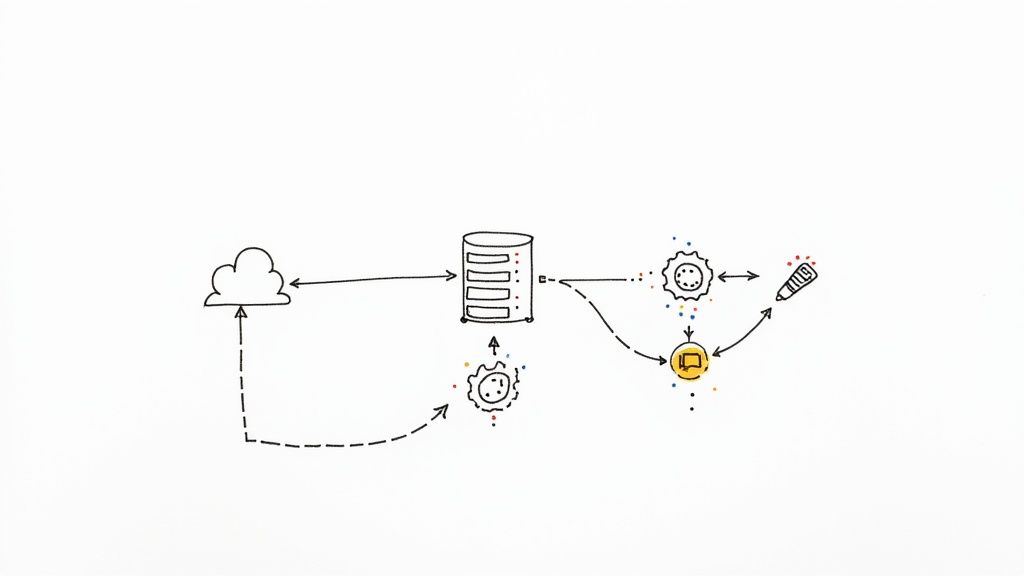
Level Up Your DevOps Game: Automating for Success
Want faster releases and smoother workflows? DevOps automation tools are essential for modern software development. This listicle presents ten leading platforms—from established players like Jenkins and Ansible to rising stars like Mergify and CircleCI—to help you choose the right DevOps automation tools for your needs. Eliminate manual tasks, reduce errors, and accelerate delivery pipelines. Explore our top ten list and find the perfect tools to optimize your DevOps processes.
1. Mergify: Streamlining Your Pull Request Workflow with Automation
Mergify is a powerful Continuous Merge Platform ideal for optimizing the pull request (PR) process within DevOps automation. By automating PR workflows, Mergify reduces CI costs, improves code security, and significantly boosts developer productivity. It's tailored for diverse teams, including software developers, DevOps engineers, QA professionals, and enterprise IT leaders, addressing the challenges of managing complex PR workflows in fast-paced environments. This platform stands out for its innovative approach to merging code, offering features like the Merge Queue and advanced Merge Protections to streamline integration and minimize conflicts. By automating repetitive tasks and providing insightful analytics, Mergify frees up developers to focus on writing code, not managing merges.
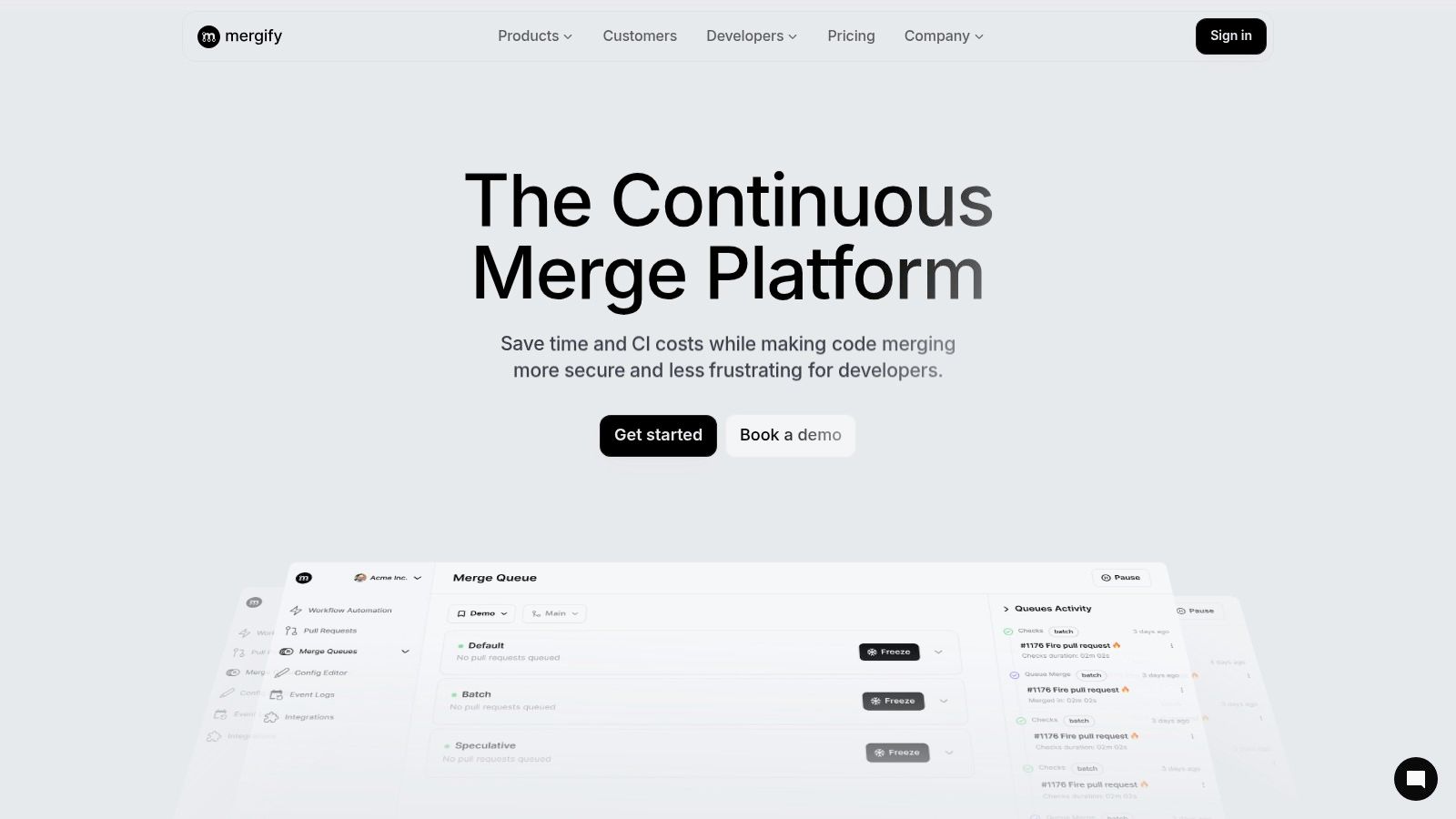
Practical Applications and Use Cases:
- Automated Merge Queue: Say goodbye to merge conflicts and tedious manual updates. Mergify automatically updates PRs with the latest main branch changes and queues them for merging, dramatically reducing integration time and CI costs by batching CI jobs. This is particularly beneficial for teams dealing with a high volume of PRs.
- Sophisticated Merge Protections: Enforce specific merge requirements based on branch patterns, required approvals, or even custom YAML-based rules. This ensures code stability and adherence to organizational policies. For instance, you can configure Mergify to block merges until all required tests pass and specific reviewers approve the changes.
- CI Insights (Beta): Gain unparalleled visibility into your CI pipelines with real-time metrics, proactive alerts, and AI-powered identification of flaky tests and infrastructure bottlenecks. This feature helps teams quickly pinpoint and resolve issues affecting CI performance, enabling faster delivery cycles.
- Streamlined PR Management: Automate tasks like PR labeling, assigning reviewers, and backporting changes. This reduces manual overhead and accelerates the code review process.
Pros:
- Dramatically reduces CI costs and build times through automated merge queues and batching of CI jobs.
- Enhances codebase stability with automatic pull request updates and sophisticated merge protection rules.
- Provides deep CI pipeline visibility and actionable insights via real-time metrics and AI-driven analytics.
- Streamlines developer workflows by automating PR management, smart labeling, and reviewer assignments.
- Trusted by diverse customers including startups and enterprises, validated by positive testimonials from engineering leaders.
Cons:
- Some advanced features like CI Insights are currently in beta, which may limit full immediate access.
- Initial setup requires defining YAML rules and workflow automation configurations, which may involve an upfront learning curve.
Implementation and Setup Tips:
- Familiarize yourself with Mergify's YAML configuration syntax to define merge rules and automation workflows tailored to your project's needs.
- Start with basic automation rules and gradually incorporate more advanced features as your team gains experience.
- Leverage Mergify's documentation and support resources to address any setup challenges.
Comparison with Similar Tools: While other tools offer aspects of PR automation, Mergify's strength lies in its comprehensive approach, combining merge queuing, advanced merge protections, and CI insights. This makes it a powerful solution for teams seeking end-to-end PR workflow optimization.
Pricing and Technical Requirements: Mergify offers various pricing plans based on the number of users and repositories. Check their website for the most up-to-date information. Technically, it integrates seamlessly with popular Git platforms like GitHub, GitLab, and Bitbucket.
Website: https://mergify.com
Mergify earns its place in this list of DevOps automation tools due to its ability to transform complex CI/CD challenges into manageable processes. It empowers engineering teams to ship higher-quality software faster and more efficiently, ultimately saving valuable time and resources.
2. Jenkins
Jenkins is a leading open-source automation server widely used among DevOps teams for building, testing, and deploying software. Its core strength lies in facilitating Continuous Integration and Continuous Delivery (CI/CD) pipelines by automating the non-human aspects of the software development lifecycle. From compiling code and running tests to deploying applications and orchestrating infrastructure changes, Jenkins handles a wide array of tasks, freeing up developers to focus on writing code. Its adaptable architecture and extensive plugin ecosystem make it a versatile tool suitable for diverse DevOps workflows, catering to everything from simple projects to complex, enterprise-grade deployments. Jenkins’s power and flexibility have cemented its place as a cornerstone of modern DevOps practices.
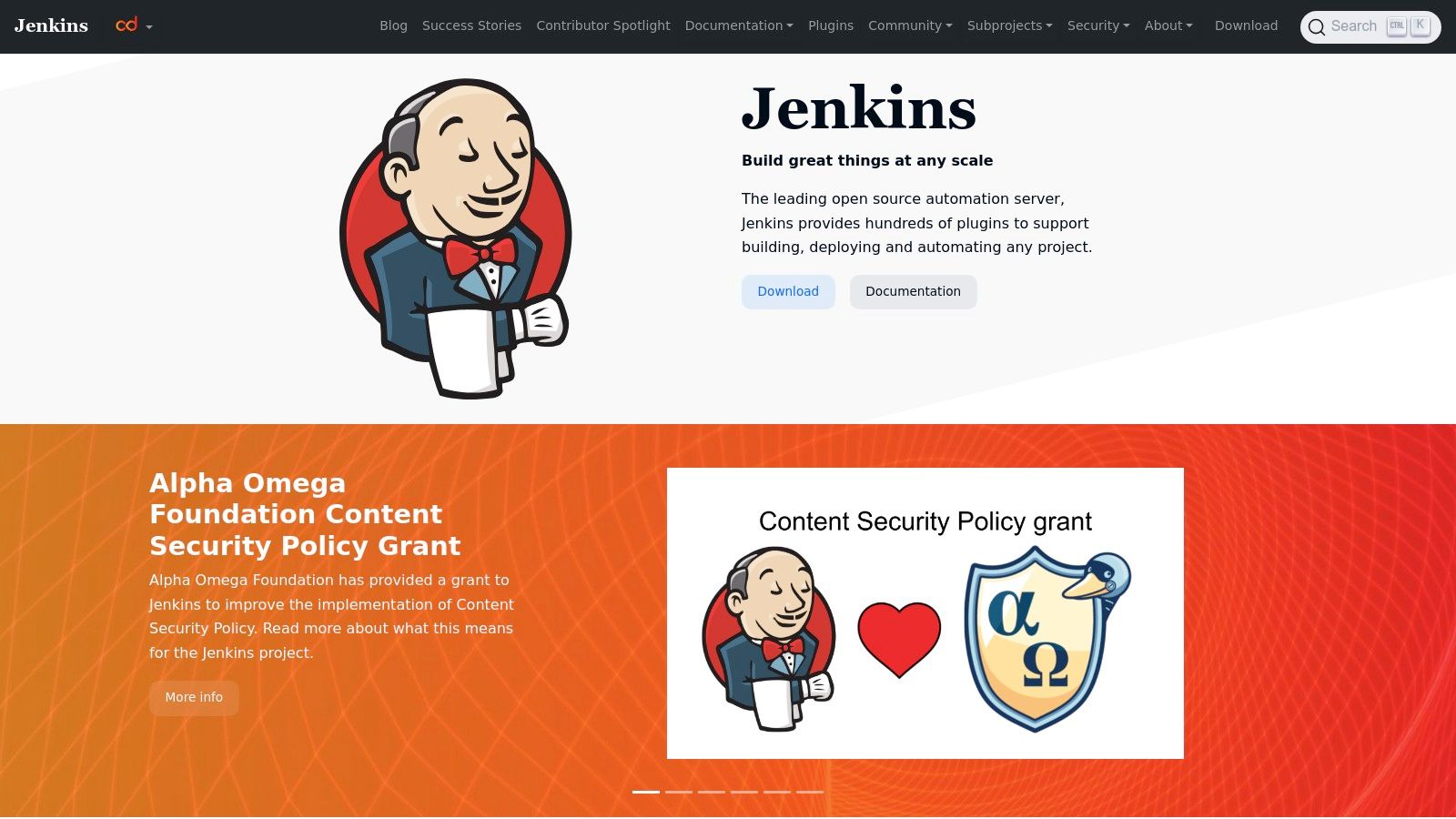
One of Jenkins's most significant advantages is its "Pipeline as Code" capability, enabled through Jenkins Pipeline and the use of Jenkinsfile. This feature allows developers to define their entire CI/CD pipeline as a script, which can be version-controlled alongside the application code. This approach ensures consistency, reproducibility, and easy collaboration within development teams. Further bolstering its flexibility, Jenkins employs a master-agent architecture that enables distributed builds. This distributed approach not only speeds up the build process by parallelizing tasks but also allows for building and testing across multiple platforms and environments. With over 1,800 plugins available, Jenkins integrates with virtually all DevOps tools, including version control systems like Git, build tools like Maven and Gradle, testing frameworks, and deployment platforms. This vast plugin ecosystem makes Jenkins highly customizable, allowing teams to tailor it precisely to their specific needs. Moreover, its web-based GUI simplifies installation and configuration, making it accessible even to those new to DevOps automation.
Features:
- Pipeline as Code with Jenkins Pipeline and Jenkinsfile
- Distributed builds with master-agent architecture
- Extensive plugin ecosystem (over 1,800 plugins)
- Easy installation and configuration with web-based GUI
- Built-in support for many version control systems
Pros:
- Completely free and open-source
- Highly customizable with an extensive plugin ecosystem
- Large and active community support
- Integrates with virtually all DevOps tools
Cons:
- User interface can be outdated and unintuitive
- Setup and maintenance can be complex for large installations
- Security requires careful configuration
- Can be resource-intensive for large installations
Pricing: Free and open-source.
Technical Requirements: Jenkins can run on various operating systems, including Windows, Linux, and macOS. It requires Java and a web browser for access to the web interface. Resource requirements depend on the size and complexity of the projects being built.
Comparison with Similar Tools: While other CI/CD tools like GitLab CI/CD, CircleCI, and Travis CI offer similar functionalities, Jenkins often stands out due to its unmatched flexibility and extensibility, particularly for complex enterprise environments. Learn more about Jenkins and how it can be enhanced with other tools.
Implementation/Setup Tips: Start with a simple project and gradually add complexity. Leverage the Jenkins community and documentation for guidance. Consider using Docker for easier deployment and management. Pay close attention to security best practices during configuration.
Website: https://www.jenkins.io/
Jenkins earns its place on this list because of its maturity, flexibility, and open-source nature. Its ability to adapt to almost any CI/CD workflow, coupled with its vibrant community and extensive plugin ecosystem, makes it a powerful and versatile tool for DevOps teams of all sizes. While it can have a steeper learning curve compared to some cloud-based CI/CD solutions, its power and customizability make it an invaluable asset for organizations looking to streamline their software development processes.
3. Ansible
Ansible is a powerful open-source automation tool that streamlines numerous DevOps processes, including configuration management, application deployment, and task automation. Its agentless architecture and use of YAML-based playbooks make it a popular choice for teams looking to simplify their infrastructure management. Ansible excels at ensuring consistent system configurations across various environments and automating repetitive tasks, freeing up valuable time for development and innovation. As a prominent player amongst devops automation tools, it offers a balance of power and simplicity that appeals to both beginners and experienced automation engineers.
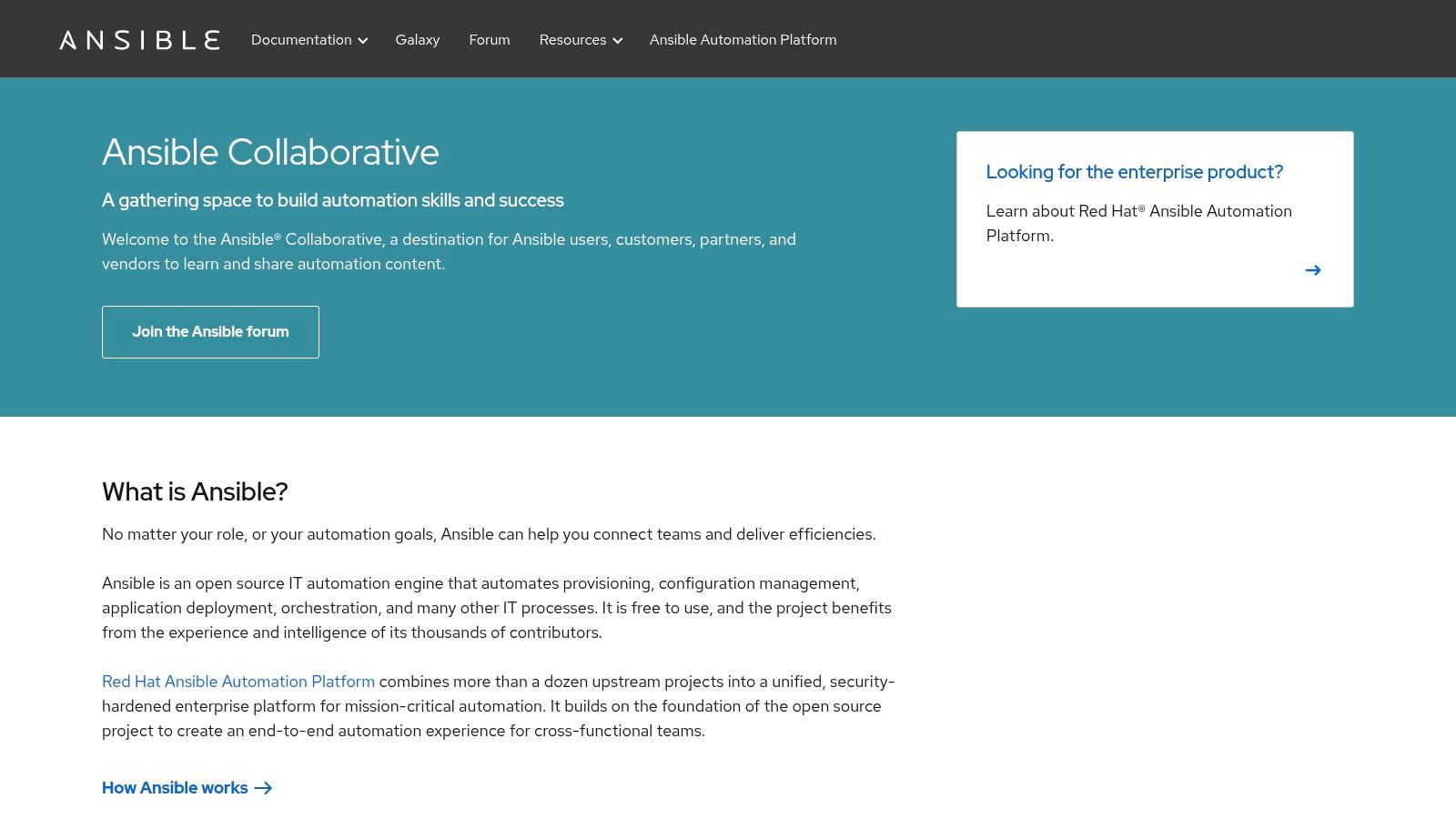
Key Features and Benefits:
- Agentless Architecture: Eliminates the need to install and manage agents on managed nodes, simplifying deployment and reducing overhead. This contrasts with tools like Chef or Puppet, which require agent installation. This makes it particularly beneficial for managing large and dynamic infrastructures.
- YAML-Based Playbooks: Automation tasks are defined in human-readable YAML playbooks, making them easy to understand, write, and maintain, even for team members with limited coding experience. This declarative approach focuses on the desired state of the system rather than the specific steps to achieve it.
- Idempotent Execution: Ensures that automation tasks can be run multiple times without causing unintended side effects. This is critical for maintaining system stability and preventing configuration drift. Ansible only makes changes when the system is not in the desired state.
- Rich Module Library: Ansible provides a vast library of pre-built modules for performing various operations, from managing files and packages to interacting with cloud providers and network devices. This allows for extensive automation possibilities out-of-the-box.
- Ansible Tower/AWX: Offers enterprise-grade management capabilities, including centralized playbook execution, role-based access control, and job scheduling. This is crucial for organizations looking to scale their automation efforts and enforce best practices.
Pros:
- Simple, human-readable YAML syntax lowers the learning curve for new users.
- Agentless architecture simplifies deployment and management.
- Excellent for configuration management and orchestration.
- Strong community support and Red Hat enterprise backing provide reliable resources and ongoing development.
Cons:
- Performance can be slower than agent-based tools, especially for very large infrastructures.
- While Windows support has improved, it remains more mature for Linux environments.
- Debugging complex playbooks can sometimes be challenging.
- Large, intricate playbooks can become difficult to maintain over time.
Implementation/Setup Tips:
- Start with simple playbooks and gradually increase complexity.
- Use Ansible Galaxy to leverage pre-built roles and modules.
- Implement version control for your playbooks using Git.
- Consider Ansible Tower/AWX for centralized management and scaling.
Pricing:
Ansible itself is open-source and free to use. Ansible Tower/AWX offers a free version with limited features and paid subscriptions for enterprise functionality.
Comparison with Similar Tools:
Compared to other devops automation tools like Chef and Puppet, Ansible stands out for its agentless nature and simplicity. Chef and Puppet, while powerful, require agent installation on managed nodes, which can add complexity to deployment and maintenance. SaltStack, another popular configuration management tool, is more comparable to Ansible in its agentless approach but can have a steeper learning curve.
Website: https://www.ansible.com/
Ansible deserves its place in this list of devops automation tools due to its ease of use, agentless architecture, and robust capabilities. Its gentle learning curve makes it an excellent entry point into the world of infrastructure automation, while its powerful features allow it to scale to meet the needs of large and complex environments. It empowers teams to automate their infrastructure effectively and efficiently, enabling them to focus on delivering value and driving innovation.
4. Docker
Docker is a leading DevOps automation tool that revolutionizes how developers build, ship, and run applications. By leveraging containerization, Docker packages applications and their dependencies into isolated units, ensuring consistent execution across various environments, from development laptops to production servers. This eliminates the dreaded "works on my machine" problem and streamlines the deployment process significantly, making it a crucial tool for implementing efficient CI/CD pipelines. Docker's portability, lightweight nature, and resource isolation capabilities contribute to faster startup times, optimized resource utilization, and enhanced reliability, making it an indispensable asset for modern DevOps practices.
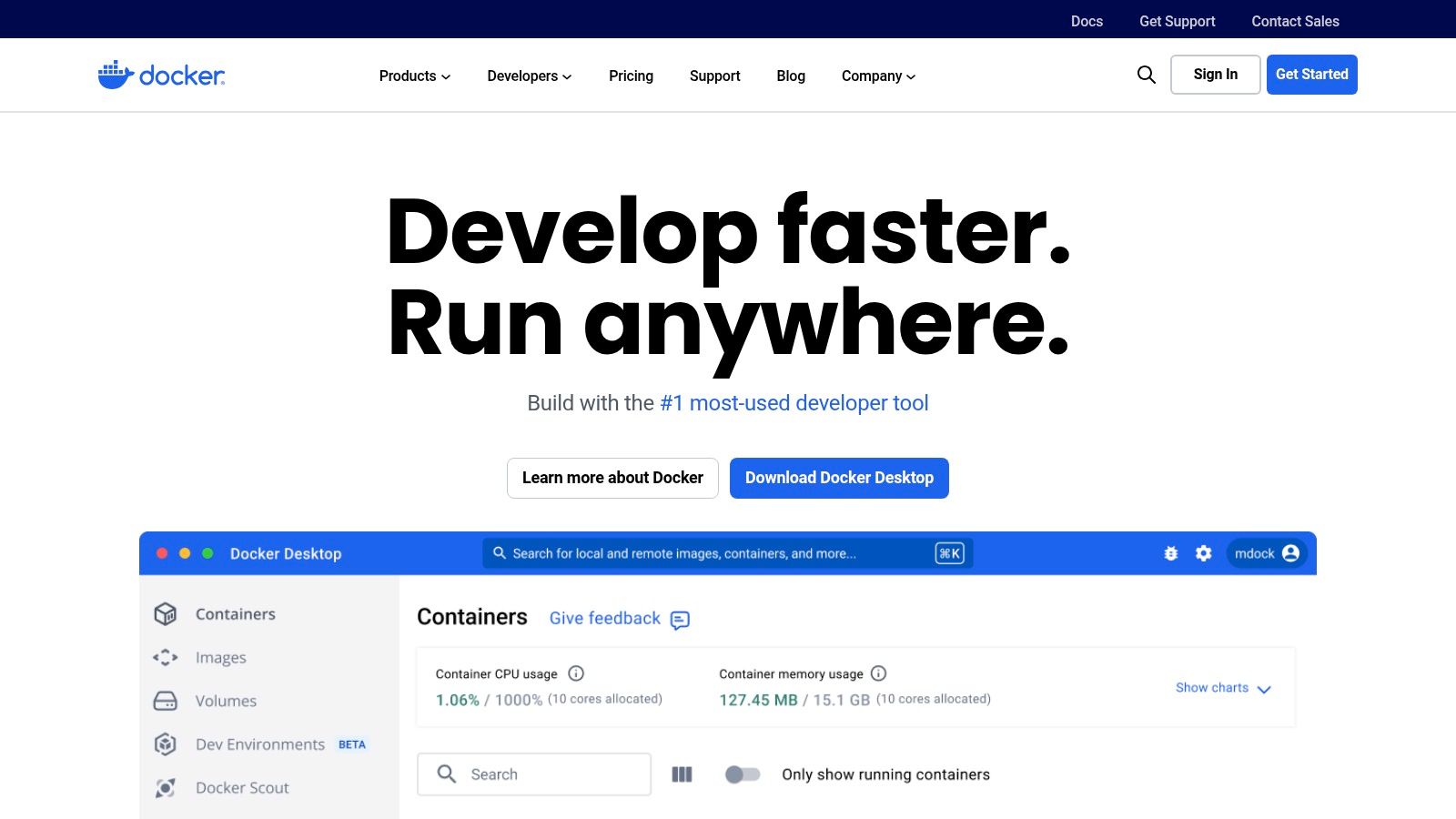
Docker's strength lies in its comprehensive ecosystem. Docker Hub provides a vast repository of pre-built images, accelerating development by allowing teams to leverage existing building blocks. Docker Compose simplifies the management of multi-container applications, enabling developers to define and orchestrate complex deployments with ease. While Docker Swarm offers built-in container orchestration, it's worth noting that Kubernetes is often preferred for large-scale deployments due to its advanced features and scalability. For instance, a microservices architecture can be efficiently containerized using Docker and then orchestrated with Kubernetes for optimal performance and resource management.
Docker offers various subscription plans, including a free personal plan and paid team and business subscriptions which provide advanced features like private repositories and enhanced security scanning. Technically, Docker Desktop is available for Windows, macOS, and Linux systems. Server-side components like the Docker Engine can be installed on a variety of Linux distributions. A basic understanding of command-line interfaces and containerization concepts is recommended for effective Docker implementation.
Compared to virtual machines (VMs), Docker containers are significantly lighter and faster. VMs virtualize the entire operating system, resulting in larger sizes and slower startup times. Docker, on the other hand, shares the host OS kernel, leading to reduced overhead and improved performance. This efficiency boost is crucial for DevOps automation, enabling quicker deployments and faster feedback loops.
One major benefit of Docker is its ability to create consistent environments across development, testing, and production, eliminating environment-specific bugs and ensuring predictable application behavior. Learn more about Docker and its security best practices. For getting started, try creating a simple Dockerfile for your application, build an image, and run it in a container to experience the benefits of this powerful DevOps automation tool firsthand.
Key Features:
- Containerization of applications with all dependencies
- Docker Compose for multi-container applications
- Docker Hub for image sharing
- Docker Swarm for orchestration
- Resource isolation and allocation
Pros:
- Consistent environments across development and production
- Lightweight compared to VMs
- Fast startup and deployment times
- Large ecosystem of pre-built images
Cons:
- Container security requires careful configuration
- Complex networking can be challenging
- Storage management can be complex
- Kubernetes often preferred for large-scale orchestration
Website: https://www.docker.com/
5. Kubernetes
Kubernetes, often abbreviated as K8s, stands as a cornerstone among DevOps automation tools, empowering teams to efficiently manage containerized applications at scale. This open-source container orchestration platform automates crucial processes like deployment, scaling, and ongoing management. Originally a Google project, Kubernetes provides the framework for running distributed systems resiliently. Its capabilities extend to handling application scaling and failover, offering a variety of deployment patterns that have made it the industry standard for container orchestration. This makes it a crucial tool for any team looking to streamline their DevOps pipeline. For software development teams, DevOps engineers, QA, IT leaders, startups, and CI/CD platform engineers, Kubernetes offers a powerful way to control the complexities of modern application deployment.
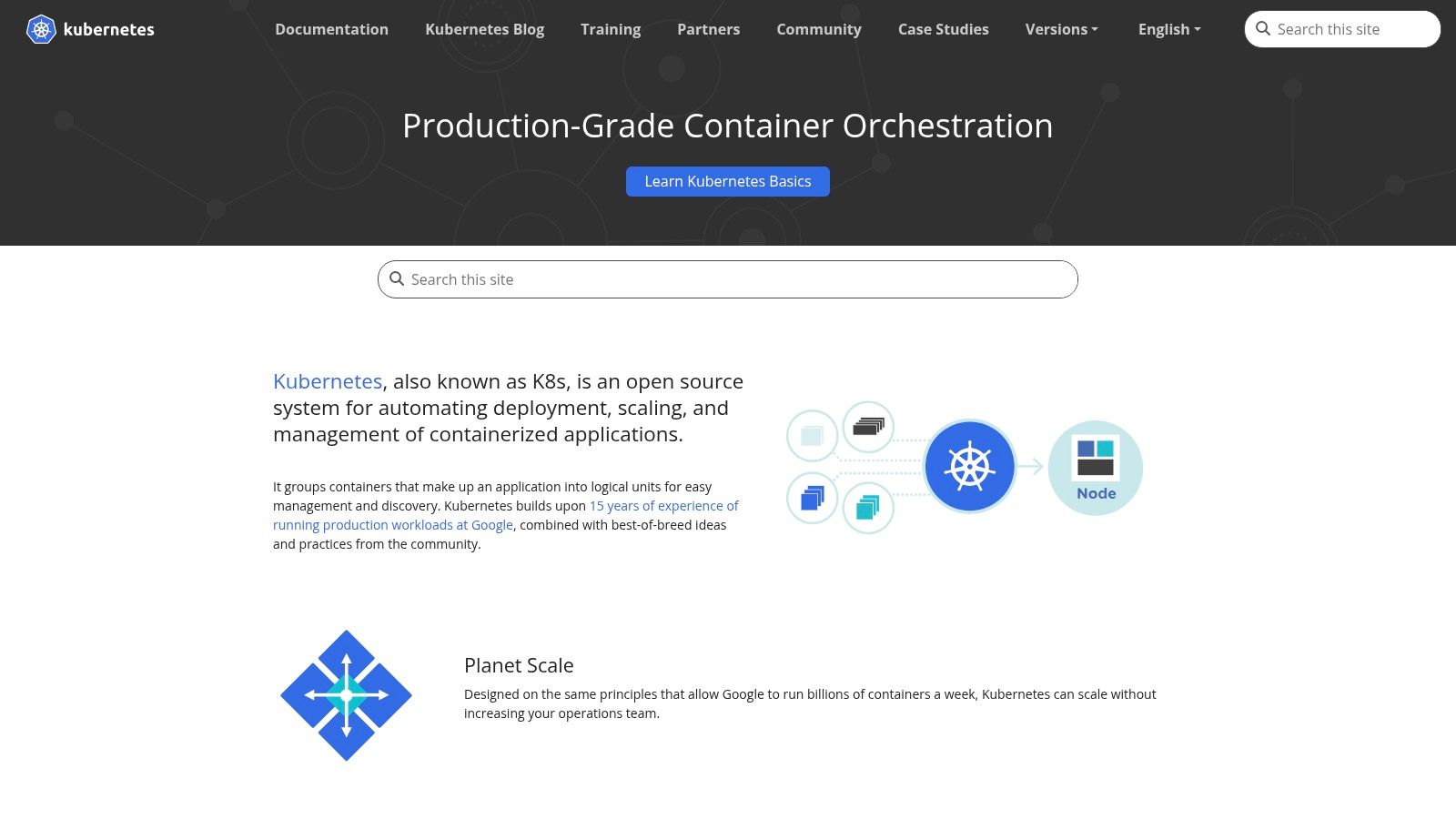
Kubernetes excels in orchestrating complex microservice architectures, enabling organizations to break down applications into smaller, manageable units. This simplifies development, deployment, and scaling while improving fault isolation. Specific features contributing to this include automated container deployment and scaling, self-healing through automatic restart or replacement of failed containers, horizontal pod autoscaling based on resource utilization, built-in service discovery and load balancing, and declarative configuration using YAML files. This declarative approach lets you define the desired state of your application, and Kubernetes takes care of ensuring it reaches and maintains that state.
Practical Applications and Use Cases:
- Managing Microservices: Kubernetes simplifies the deployment and scaling of complex microservice applications, ensuring high availability and fault tolerance.
- Continuous Integration/Continuous Delivery (CI/CD): Kubernetes integrates seamlessly into CI/CD pipelines, automating deployments and rollbacks.
- Cloud-Native Applications: Kubernetes provides the ideal platform for deploying and managing cloud-native applications designed to thrive in dynamic cloud environments.
- Batch Processing: Kubernetes can manage batch jobs, ensuring efficient resource utilization and timely completion.
Comparison with Similar Tools:
While other container orchestration tools exist (e.g., Docker Swarm, Nomad), Kubernetes has emerged as the dominant player due to its robust features, large community, and extensive cloud provider support. Its comprehensive set of capabilities often makes it the preferred choice for complex deployments.
Implementation and Setup Tips:
- Start with a managed Kubernetes service: Cloud providers offer managed Kubernetes services (e.g., Google Kubernetes Engine, Amazon Elastic Kubernetes Service, Azure Kubernetes Service) that simplify setup and maintenance. This is often a much easier starting point than self-managing a Kubernetes cluster.
- Use Helm: Helm is a package manager for Kubernetes that simplifies the deployment and management of applications.
- Invest in training: Kubernetes has a steep learning curve, so investing in training for your team is essential.
Pricing and Technical Requirements:
Kubernetes itself is open-source and free to use. However, running Kubernetes requires infrastructure, which can incur costs depending on whether you self-host or use a managed service. Managed services typically have a pricing model based on resource consumption. Technical requirements vary based on deployment size and complexity but generally involve servers, networking, and storage resources.
Pros:
- Powerful orchestration for complex microservice architectures
- Strong ecosystem and cloud provider support
- High availability and fault tolerance
- Declarative configuration and desired state management
Cons:
- Steep learning curve and complex architecture
- Resource-intensive for small deployments
- Requires significant expertise to maintain properly
- Security configuration can be challenging
Website: https://kubernetes.io/
Kubernetes’s power and flexibility have cemented its position as a leading DevOps automation tool. While the learning curve is steep, the benefits of mastering Kubernetes for managing complex, containerized deployments are undeniable. Its position at number five on this list reflects its critical role in modern DevOps practices.
6. Terraform
Terraform secures its spot as a top DevOps automation tool due to its powerful infrastructure-as-code (IaC) capabilities. It empowers teams to define and manage their entire infrastructure through declarative configuration files using HashiCorp Configuration Language (HCL). This allows for repeatable and consistent deployments across diverse environments, from on-premises servers to various cloud providers like AWS, Azure, and Google Cloud. Terraform's focus on managing external resources through APIs and meticulously tracking resource state makes it an indispensable tool for streamlining infrastructure automation. This translates into faster deployments, reduced human error, and improved collaboration within DevOps teams.
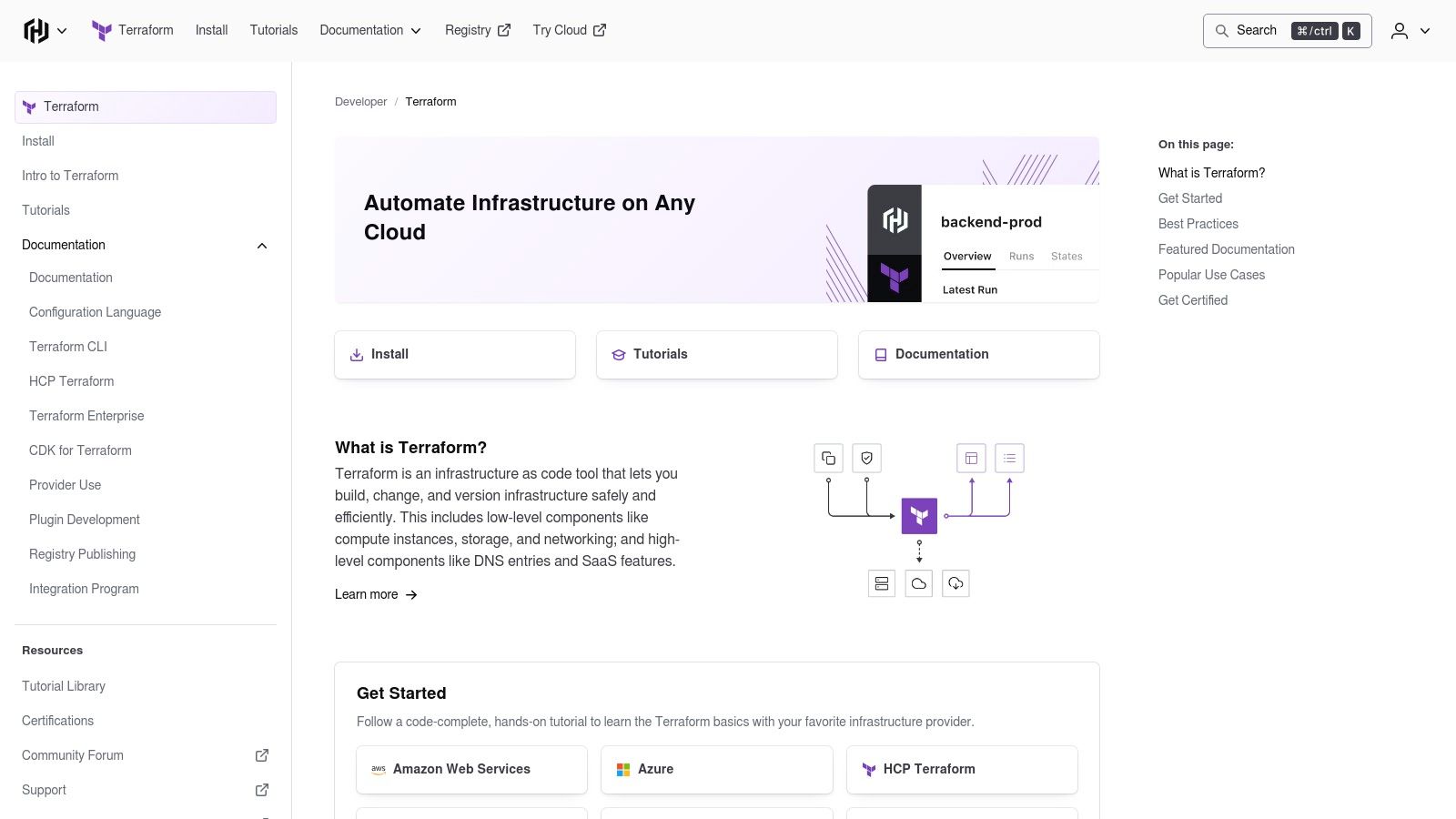
Terraform's "plan and apply" workflow allows you to preview infrastructure changes before they are implemented, providing a safety net and enabling predictable infrastructure updates. The modularity offered by Terraform allows for reusable infrastructure components, further enhancing efficiency and maintainability. For instance, you could define a module for deploying a standard web server cluster and reuse it across different projects and environments. This significantly reduces code duplication and promotes standardization. Imagine easily spinning up identical development, staging, and production environments with just a few lines of code - that’s the power Terraform brings to DevOps automation.
Features:
- Declarative Infrastructure as Code with HCL: Define desired infrastructure state, and Terraform handles the provisioning and management.
- State Management: Keeps track of real-world resources and their configurations, ensuring consistency and enabling efficient updates.
- Multi-Cloud Provider Support: Manage infrastructure across various cloud platforms with a unified workflow.
- Plan and Apply Workflow: Preview and validate infrastructure changes before applying them, minimizing unexpected consequences.
- Module System: Create and reuse infrastructure components for consistent and efficient deployments.
Pros:
- Provider-Agnostic: Supports a vast array of cloud providers and on-premises infrastructure, offering maximum flexibility.
- Robust State Management: Accurately tracks infrastructure state, enabling repeatable and reliable deployments.
- Declarative Syntax: Focus on the desired end-state rather than the steps to get there, simplifying complex deployments.
- Ideal for Cloud Infrastructure Management: Excels in managing and automating cloud resources, significantly boosting DevOps efficiency.
Cons:
- State Management Complexity: Managing state in team environments can be challenging and requires careful coordination.
- Limited Configuration Management: Primarily focused on infrastructure provisioning rather than detailed configuration management.
- HCL Learning Curve: Requires learning the HCL syntax, which can be a barrier to entry for some users.
- Potential Breaking Changes with Version Upgrades: While infrequent, version upgrades can sometimes introduce breaking changes requiring code adjustments.
Pricing: Terraform itself is open-source and free to use. However, costs might be incurred for the underlying infrastructure and resources provisioned via Terraform on various cloud platforms. HashiCorp also offers Terraform Cloud, a paid SaaS offering with features like remote state management, collaboration tools, and private module registries.
Technical Requirements: Terraform runs on various operating systems (Windows, macOS, Linux) and requires minimal dependencies.
Comparison with Similar Tools: While tools like CloudFormation (AWS-specific) and ARM templates (Azure-specific) provide similar IaC capabilities, Terraform's key advantage lies in its provider-agnostic approach. This enables managing infrastructure across multiple cloud platforms with a single tool and a consistent workflow. Tools like Ansible and Chef are more geared toward configuration management and less focused on infrastructure provisioning.
Implementation/Setup Tips:
- Download and Install Terraform: Choose the appropriate package for your operating system.
- Configure Credentials for Cloud Providers: Set up access keys and secrets to allow Terraform to interact with your chosen cloud platforms.
- Define Your Infrastructure in HCL: Create
.tffiles to describe your desired infrastructure components. - Use
terraform init: Initialize the working directory and download necessary plugins. - Use
terraform plan: Preview the changes Terraform will make to your infrastructure. - Use
terraform apply: Apply the changes and provision your infrastructure.
Website: https://www.terraform.io/
Terraform is a valuable asset in any DevOps toolkit, particularly for teams working with multi-cloud environments or seeking to automate infrastructure management tasks. Its declarative nature and robust state management capabilities make it a powerful tool for improving consistency, reliability, and speed in infrastructure deployments, making it a crucial component of effective DevOps automation.
7. GitLab CI/CD
GitLab CI/CD is a powerful DevOps automation tool built directly into the GitLab platform. This tight integration provides continuous integration, delivery, and deployment capabilities, streamlining the entire software development lifecycle. As developers push code changes to their GitLab repositories, GitLab CI/CD automatically builds, tests, and deploys the application based on a predefined pipeline. This automation eliminates manual steps, reduces errors, and accelerates the delivery of software. Using YAML files (.gitlab-ci.yml) to define pipelines offers flexibility and version control for your CI/CD configurations. This seamless integration with GitLab's repository management creates a single, unified platform for the entire DevOps workflow.
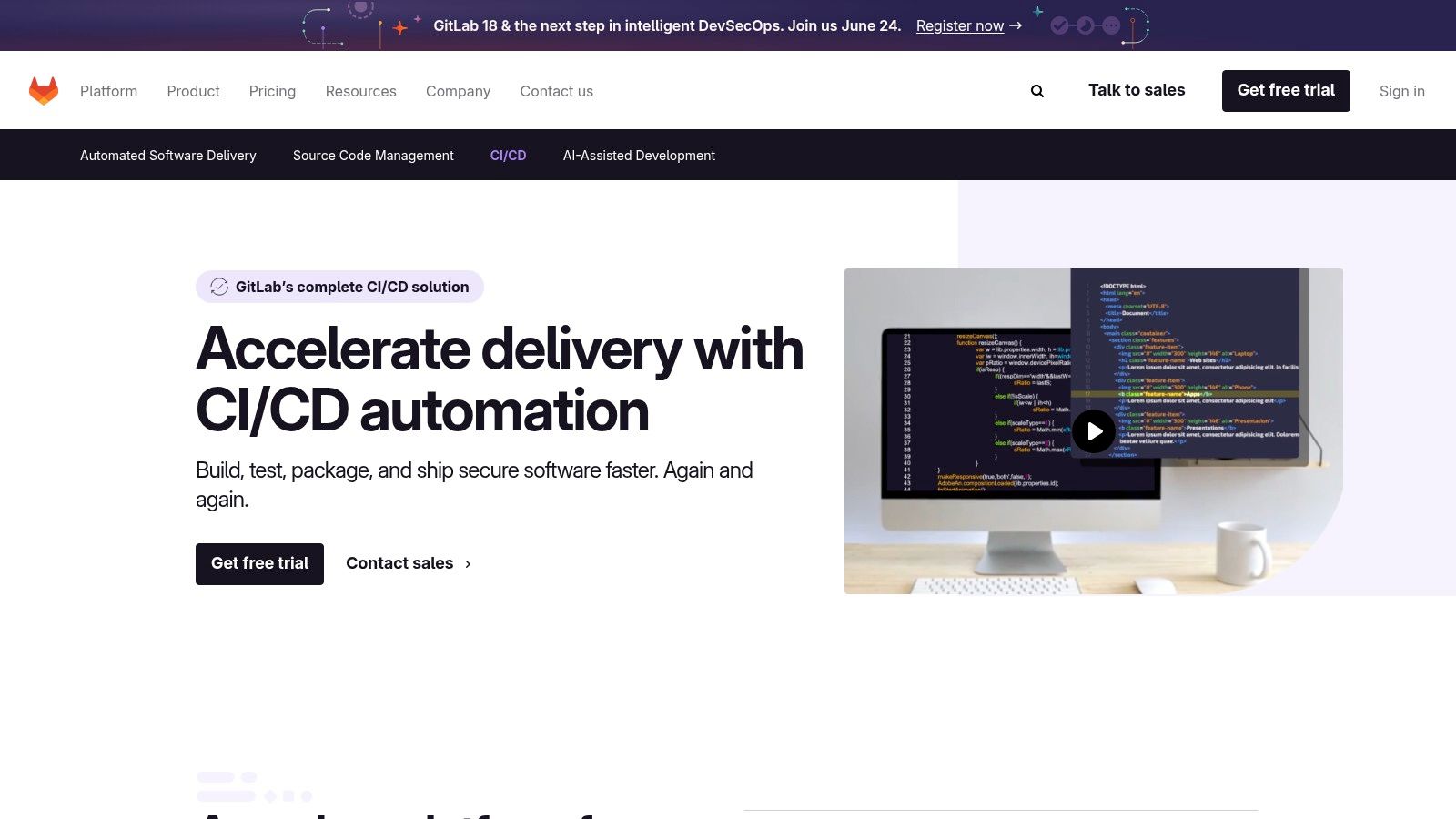
A key strength of GitLab CI/CD is its Auto DevOps feature. This simplifies CI/CD setup by automatically configuring pipelines based on best practices. This is especially helpful for projects starting with DevOps, providing a solid foundation that can be further customized as needed. For more complex projects, multi-stage pipelines with dependencies and caching allow for sophisticated workflows, ensuring efficient resource utilization and faster build times. The integrated container registry provides a centralized location for storing and managing Docker images used in the CI/CD process, further streamlining the workflow.
GitLab CI/CD's intuitive pipeline visualization and management tools allow teams to easily monitor the progress of their pipelines and quickly identify any bottlenecks. Built-in security scanning and testing capabilities enhance the security of the software development lifecycle by identifying vulnerabilities early in the process. For teams already using GitLab for repository management, GitLab CI/CD is a natural extension, offering a single platform for the entire DevOps lifecycle. This integration simplifies toolchain management and enhances collaboration.
While GitLab CI/CD offers numerous advantages, it's essential to consider its limitations. Being tied to the GitLab platform can be a drawback for organizations committed to other version control systems or preferring standalone CI/CD tools like Jenkins, which boasts a more extensive plugin ecosystem. Self-hosted GitLab instances can be resource-intensive, requiring significant computing power and storage, especially for large projects. While GitLab CI/CD offers a free tier, many advanced features, such as Auto DevOps and security scanning, require paid subscriptions.
Implementation is straightforward; you simply create a .gitlab-ci.yml file in the root of your project. This file defines the stages of your pipeline, the jobs to be executed in each stage, and any dependencies between them. Learn more about GitLab CI/CD and specifically about managing variables within your pipeline configuration. GitLab's comprehensive documentation and active community provide ample support for getting started and troubleshooting any issues.
GitLab CI/CD deserves its place among top DevOps automation tools due to its seamless integration with the GitLab platform, comprehensive feature set, and intuitive user interface. It offers a robust and efficient solution for automating the entire software development lifecycle, making it an excellent choice for teams seeking a unified DevOps platform. However, organizations should carefully evaluate their needs and resources to determine if GitLab CI/CD is the right fit, especially considering its tie-in to the GitLab ecosystem and the potential resource requirements for self-hosted instances.
8. Chef
Chef is a powerful automation platform that earns its place among top DevOps automation tools by transforming infrastructure management into code. This "Infrastructure as Code" (IaC) approach enables you to define, deploy, and manage your entire infrastructure—from servers and network devices to applications and services—programmatically. Chef uses a pure-Ruby, domain-specific language (DSL) to write system configurations, organized into "cookbooks" (containing recipes) and "recipes" (defining specific configurations). This framework allows for consistent and repeatable infrastructure management across complex environments.
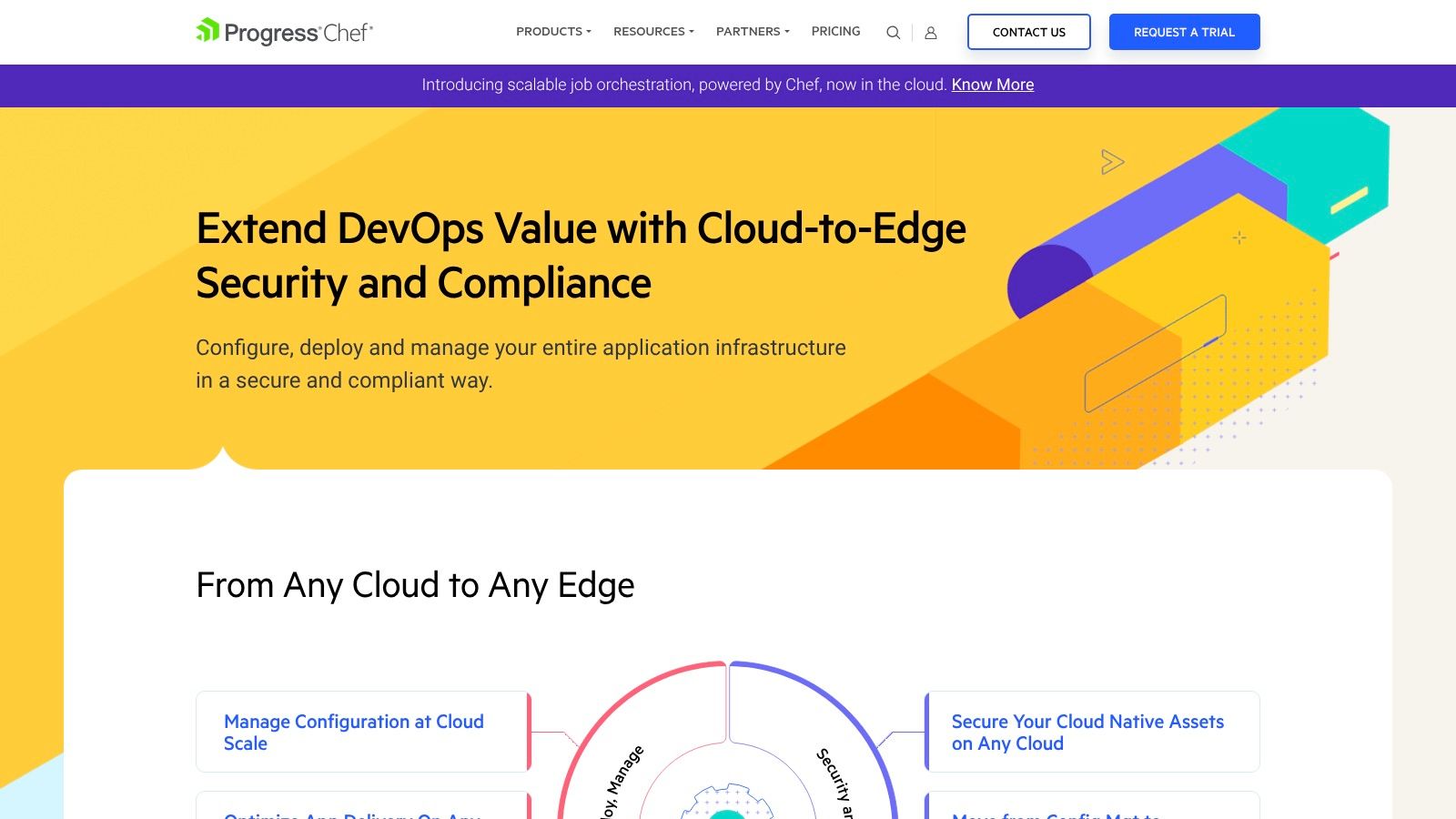
Chef's strength lies in its flexibility and power, particularly for complex, large-scale infrastructures. Imagine automating the deployment of a web application cluster across multiple servers. With Chef, you can define the entire setup—installing web servers, configuring databases, deploying application code, and managing load balancers—within your cookbooks and recipes. This ensures consistency across all environments (development, testing, production) and significantly reduces the risk of manual errors. Chef's agent-based architecture, where a Chef client runs on each managed node, facilitates real-time monitoring and enforcement of desired configurations.
Key features include:
- Infrastructure as Code with Ruby-based DSL: This provides a highly customizable and expressive way to manage infrastructure configurations.
- Cookbooks and Recipes for Configuration Management: These organizational structures enable modular and reusable configuration definitions.
- Chef Infra Server: A centralized management server for storing cookbooks, managing nodes, and orchestrating deployments.
- Test-Driven Infrastructure with Chef InSpec: This framework allows you to write automated tests to verify compliance and ensure infrastructure stability.
- Habitat for Application Automation: This feature focuses on automating the deployment and management of applications across different environments.
Pros:
- Highly flexible and powerful Ruby-based DSL: Offers extensive control and customization options.
- Excellent for complex, large-scale infrastructures: Its robust architecture handles intricate deployments efficiently.
- Strong testing capabilities with Chef InSpec: Promotes infrastructure stability and compliance.
- Comprehensive ecosystem for enterprise environments: Provides a mature set of tools and integrations.
Cons:
- Steeper learning curve than some competitors: The Ruby DSL can be challenging for beginners.
- Agent-based architecture requires installation on nodes: Adds an extra layer of management.
- More complex setup compared to tools like Ansible: Requires a deeper understanding of Chef's architecture.
- Ruby knowledge beneficial for advanced usage: While basic usage is possible without deep Ruby expertise, advanced customizations require Ruby proficiency.
Implementation/Setup Tips:
- Start with a well-defined infrastructure plan and map your requirements to Chef's cookbook and recipe structure.
- Leverage Chef's testing capabilities with InSpec to ensure infrastructure reliability and compliance.
- Utilize the Chef Infra Server for centralized management and improved scalability.
- Consider using pre-built cookbooks from the Chef Supermarket to accelerate your automation efforts.
Comparison:
Compared to tools like Ansible (which uses a simpler YAML-based syntax and agentless architecture), Chef offers more power and flexibility but comes with increased complexity. Chef is often preferred for managing large, complex infrastructures where fine-grained control and comprehensive testing are crucial. Ansible might be a better choice for smaller deployments or teams seeking a quicker setup and easier learning curve.
Pricing: Chef offers various pricing plans, including open-source and commercial options. Specific pricing details are available on their website.
Technical Requirements: Chef requires a Chef server and Chef client agents installed on the managed nodes. The server can be deployed on various platforms, including Linux and cloud environments. Ruby knowledge is helpful, especially for advanced customization.
Website: https://www.chef.io/
Chef is a valuable asset in the DevOps toolkit, enabling infrastructure automation at scale and fostering a more efficient and reliable IT environment. Its powerful DSL, comprehensive features, and strong testing capabilities make it an excellent choice for organizations managing complex infrastructures and seeking robust automation solutions.
9. Puppet
Puppet is a powerful configuration management tool widely used among DevOps automation tools to automate the provisioning and management of your infrastructure. Using a declarative language, you define the desired state of your systems, and Puppet ensures they are brought to and maintained in that state. This eliminates manual configuration, reducing errors and ensuring consistency across your infrastructure. Puppet follows a client-server architecture where the Puppet server, or "Puppet master," holds the desired configurations defined in Puppet code (manifests), and agents installed on target nodes (servers, virtual machines, network devices) apply those configurations. This centralized approach simplifies managing large and complex infrastructures.
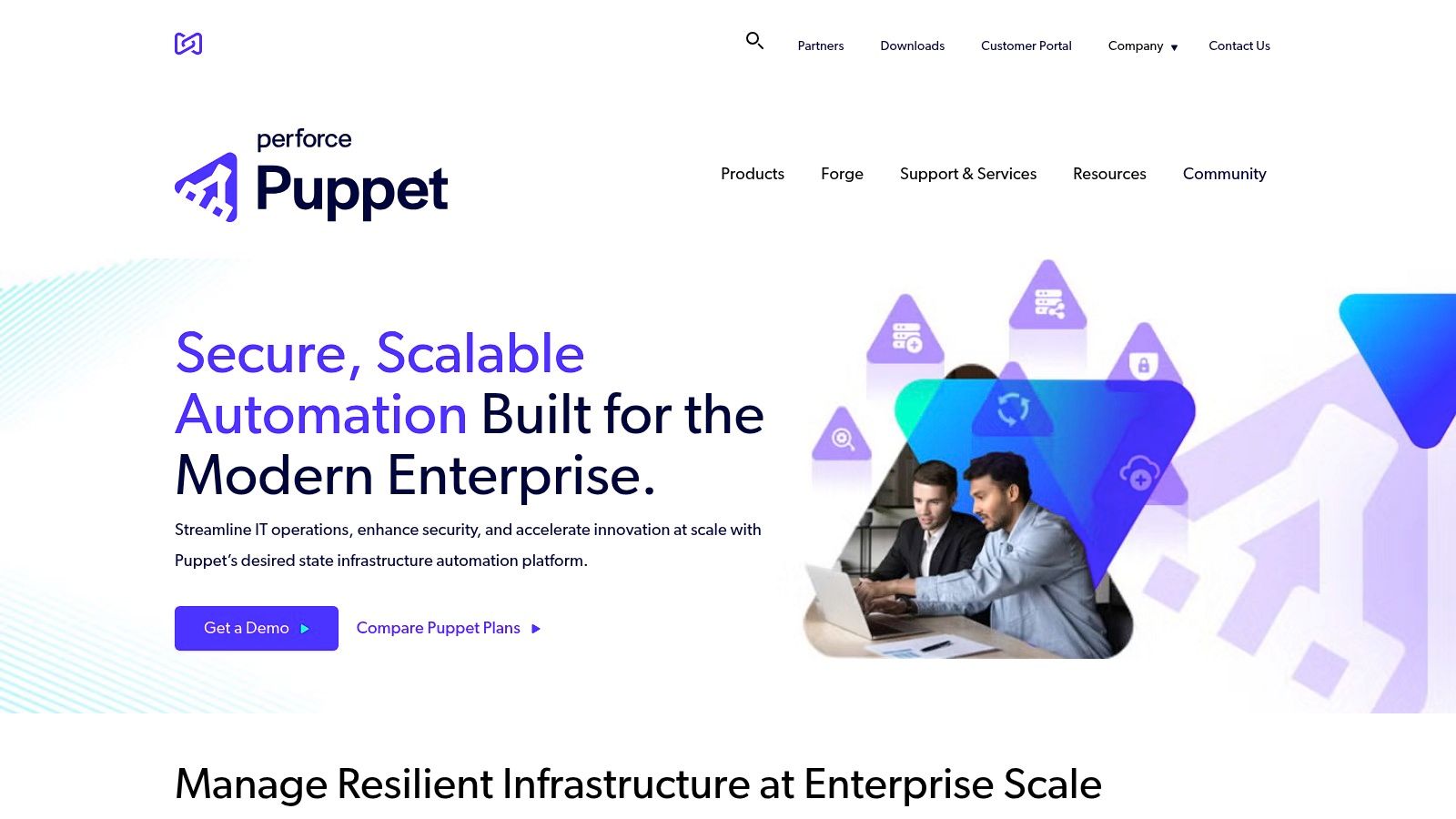
Puppet shines in scenarios requiring robust configuration management and automation. For instance, imagine deploying a web application across multiple servers. With Puppet, you can define the necessary software packages, configurations, and dependencies in a Puppet module. This module can then be applied to all target servers, ensuring a consistent and repeatable deployment process. Puppet also excels at managing user accounts, setting file permissions, and enforcing security policies across your infrastructure. Its model-driven approach, using Puppet modules, promotes code reusability and simplifies complex configurations. Furthermore, Puppet’s role-based access control (RBAC) features are crucial for enterprise environments, providing granular control over who can manage which parts of the infrastructure.
Puppet’s reporting and compliance tools are invaluable for DevOps teams. They provide insights into the state of your infrastructure and help identify any configuration drift or compliance violations. This ensures adherence to security best practices and regulatory requirements. Puppet integrates well with other DevOps tools, enhancing its automation capabilities within a larger CI/CD pipeline.
Features:
- Declarative Language: Define the desired system state, not the steps to achieve it.
- Model-Driven Approach: Puppet modules encapsulate reusable configuration logic.
- Role-Based Access Control (RBAC): Granular control over access to configurations.
- Puppet Enterprise: Commercial version with advanced features and support.
- Built-in Reporting and Compliance Tools: Monitor and enforce desired configurations.
Pros:
- Mature Platform: Proven stability and reliability in enterprise environments.
- Strong Model-Driven Approach: Efficient and reusable configuration management.
- Excellent for Enforcing Compliance: Maintain adherence to security policies and regulations.
- Comprehensive Reporting Capabilities: Gain insights into infrastructure state and configuration drift.
Cons:
- Steep Learning Curve: Mastering the Puppet DSL can be challenging initially.
- Requires Agents: Managed nodes must have the Puppet agent installed.
- Server-Agent Architecture: Can be complex to set up and manage initially.
- Enterprise Features Require Paid License: Advanced features and commercial support come at a cost.
Pricing: Puppet offers open-source and commercial versions. Puppet Enterprise pricing is based on the number of managed nodes and requires contacting sales for a quote.
Technical Requirements: Puppet Server requires a Linux-based operating system. Puppet agents can be installed on various operating systems, including Linux, Windows, and macOS.
Comparison with Similar Tools (Chef, Ansible, SaltStack): While similar in functionality to Chef, Ansible, and SaltStack, Puppet differentiates itself through its strong emphasis on a declarative language and its mature model-driven architecture. Chef also uses a declarative language (Ruby-based) but is generally considered more complex. Ansible and SaltStack offer more agentless options, making them simpler to deploy in some scenarios, but might lack the depth of Puppet's configuration management capabilities.
Implementation/Setup Tips:
- Start with a small test environment to familiarize yourself with Puppet's concepts.
- Leverage existing Puppet modules from the Puppet Forge to accelerate your automation efforts.
- Implement a version control system for your Puppet code.
- Invest time in learning the Puppet DSL for maximizing its potential.
Website: https://puppet.com/
Puppet deserves its place on this list of DevOps automation tools due to its robust configuration management capabilities, mature platform, and powerful reporting tools. While it has a learning curve, its strengths make it a valuable asset for organizations seeking to automate their infrastructure and enforce consistent configurations. It’s particularly well-suited for enterprise environments that prioritize stability, security, and compliance.
10. CircleCI
CircleCI is a powerful cloud-based continuous integration and continuous delivery (CI/CD) platform that earns its place among the top DevOps automation tools for its ease of use, speed, and comprehensive features. It empowers development teams to automate the entire software development lifecycle, from building and testing to deployment, fostering rapid releases with enhanced confidence. CircleCI caters to a variety of needs, offering both cloud-hosted and self-hosted options, supporting a broad spectrum of programming languages and platforms. This flexibility makes it a suitable choice for everything from small open-source projects to large-scale enterprise applications.
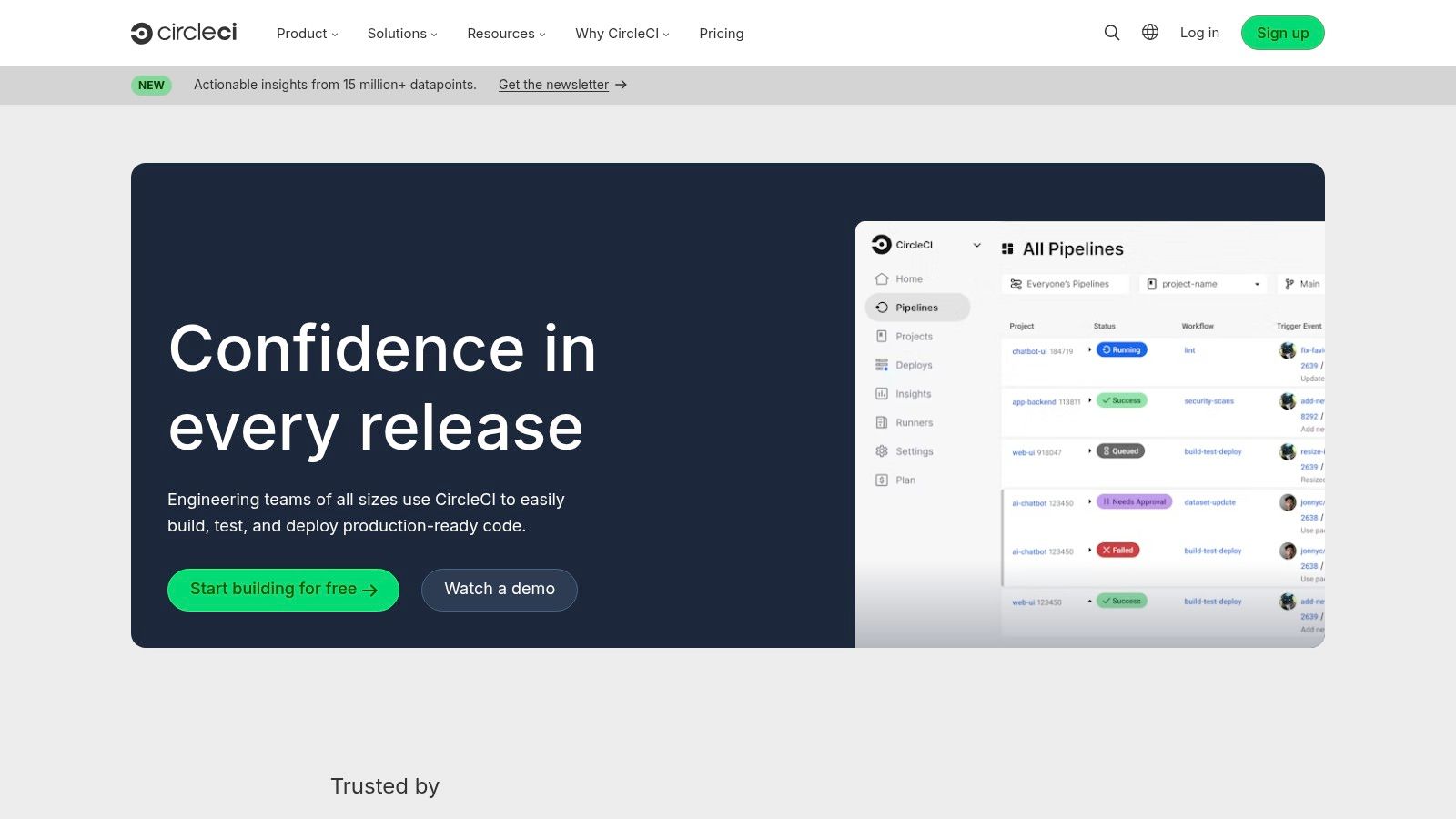
One of CircleCI's standout features is its configuration-as-code approach using a config.yml file. This allows developers to define and manage their CI/CD pipelines in a version-controlled manner, promoting transparency and reproducibility. Parallel test execution significantly reduces build times, a crucial factor for fast-paced development environments. Furthermore, CircleCI's "Orbs" provide reusable configuration packages and integrations, streamlining workflows and reducing boilerplate configuration. Robust Docker support, including custom executor types, allows for highly customized and containerized build environments.
Practical Applications and Use Cases:
- Automating Mobile App Builds and Deployments: CircleCI seamlessly integrates with mobile development workflows, enabling automated building, testing, and deployment of iOS and Android applications.
- Web Application CI/CD: Streamlining the development process for web applications by automating testing, code analysis, and deployments to various hosting platforms.
- Microservice Architectures: Facilitating independent builds, tests, and deployments of individual microservices, ensuring a robust and scalable architecture.
- Infrastructure as Code: Integrating with tools like Terraform allows for automated infrastructure provisioning and management alongside application deployments.
Comparison with Similar Tools (e.g., Jenkins):
While Jenkins offers greater customization, CircleCI excels in its user-friendly interface and ease of setup. Jenkins, being open-source, requires more manual configuration and maintenance, whereas CircleCI provides a managed experience. For teams prioritizing speed and simplicity, CircleCI often emerges as the preferred choice. However, for highly specialized or complex pipeline requirements, Jenkins' flexibility might be more advantageous.
Implementation and Setup Tips:
- Start with the free tier to explore CircleCI's features and capabilities.
- Leverage pre-built Orbs to integrate with common tools and services.
- Optimize your
config.ymlfor parallel execution to minimize build times. - Utilize CircleCI's insights and analytics to monitor pipeline performance and identify areas for improvement.
Pricing: CircleCI offers a free tier for open-source projects and small teams. Paid plans provide increased resources, concurrency, and support, scaling to accommodate the needs of larger organizations.
Technical Requirements: Primarily cloud-based, accessible through a web browser. The self-hosted option requires dedicated infrastructure.
Pros:
- Easy setup and intuitive user interface.
- Excellent documentation and developer experience.
- Fast performance with parallel execution.
- Flexible pricing with a free tier for small projects.
Cons:
- Can become costly for large teams or complex pipelines.
- Limited customization compared to Jenkins.
- Primarily cloud-focused (though self-hosted is available).
- Some advanced features are only available in paid tiers.
Website: https://circleci.com/
CircleCI stands as a valuable DevOps automation tool, particularly suited for teams seeking a balance between ease of use and powerful features. Its cloud-native approach, coupled with comprehensive integrations and a vibrant community, makes it a compelling choice for modern software development workflows.
Top 10 DevOps Automation Tools Comparison
| Tool | Core Features/Characteristics | User Experience/Quality ★ | Value Proposition 💰 | Target Audience 👥 | Unique Selling Points ✨ |
|---|---|---|---|---|---|
| 🏆 Mergify | Continuous merge automation, Merge Queue, Merge Protections, AI-driven CI Insights | ★★★★★ Reliable automation, real-time CI metrics | 💰 Cost & time reduction via CI batching | 👥 Dev teams, DevOps, QA, Enterprises | ✨ AI-powered CI insights, intelligent scheduling, YAML rules |
| Jenkins | Pipeline as Code, master-agent architecture, 1800+ plugins | ★★★★ Large community, customizable but UI dated | 💰 Free & open-source | 👥 DevOps engineers, developers | ✨ Extensive plugin ecosystem, highly customizable |
| Ansible | Agentless, YAML playbooks, idempotent execution | ★★★★ Simple syntax, reliable | 💰 Free & open-source | 👥 Sysadmins, DevOps, automation engineers | ✨ Agentless design, human-readable YAML |
| Docker | Containerization, Docker Compose, Docker Hub, Swarm | ★★★★ Consistent, lightweight containerization | 💰 Free & enterprise options | 👥 Developers, DevOps, sysadmins | ✨ Portable containers, fast deployment |
| Kubernetes | Automated container orchestration, self-healing, autoscaling | ★★★★ Powerful but complex | 💰 Free & enterprise support | 👥 Large-scale DevOps, cloud architects | ✨ Industry standard for orchestration, high scalability |
| Terraform | Declarative IaC, multi-cloud support, state management | ★★★★ Cloud infrastructure consistency | 💰 Free & enterprise licensing | 👥 Cloud engineers, infra teams | ✨ Provider-agnostic, reusable modules |
| GitLab CI/CD | Integrated CI/CD, pipeline as code, Auto DevOps | ★★★★ Seamless GitLab integration | 💰 Freemium; paid tiers for advanced | 👥 GitLab users, DevOps teams | ✨ All-in-one DevOps platform |
| Chef | Ruby-based DSL, cookbooks/recipes, test-driven infra | ★★★★ Flexible but steep learning curve | 💰 Enterprise pricing | 👥 Enterprises, infra engineers | ✨ Powerful Ruby DSL, strong testing capabilities |
| Puppet | Declarative config, model-driven, compliance tools | ★★★★ Mature & stable, steep learning | 💰 Enterprise licenses | 👥 Enterprises, compliance teams | ✨ Robust compliance & reporting |
| CircleCI | Cloud/self-hosted, parallel tests, reusable Orbs | ★★★★ Intuitive, fast execution | 💰 Free tier + paid subscriptions | 👥 Dev teams, startups | ✨ Fast pipelines, first-class Docker support |
Choosing the Right DevOps Automation Tools for Your Needs
Selecting the right DevOps automation tools is crucial for maximizing efficiency and achieving your development goals. We've explored a range of powerful solutions, from configuration management powerhouses like Ansible, Chef, and Puppet to CI/CD platforms like Jenkins, GitLab CI/CD, and CircleCI. Containerization tools like Docker and orchestration platforms like Kubernetes are essential for modern deployments, while infrastructure-as-code tools like Terraform provide repeatability and scalability. Each tool offers unique strengths and addresses specific aspects of the DevOps lifecycle. Remember that the best tools for your team depend on factors such as team size, project complexity, existing infrastructure, budget, and specific automation needs.
Key takeaways from this list include the importance of integrating your chosen tools to create a seamless workflow and understanding the core function of each category of tool. For example, while Jenkins and GitLab CI/CD both offer CI/CD capabilities, understanding their nuances and strengths is vital for choosing the right fit. Similarly, choosing between configuration management tools like Chef, Puppet, and Ansible hinges on understanding their specific approaches and your infrastructure needs. To delve deeper into the world of DevOps automation and explore a wider range of tools and strategies, check out this comprehensive guide on DevOps automation tools from Atlassian. This resource offers valuable insights to broaden your understanding and help inform your tooling decisions.
By carefully evaluating the options and considering your specific context, you can build a robust DevOps toolchain that empowers your team to deliver high-quality software faster and more reliably. Successful DevOps implementation requires a strategic approach to tool selection and integration, focusing on collaboration, automation, and continuous improvement.
Streamline your pull request workflow and enhance your team's productivity with powerful merge automation. Mergify is a leading DevOps automation tool that integrates seamlessly with your existing Git workflow to simplify merging, automate repetitive tasks, and boost developer efficiency. Explore Mergify today and discover the power of automated pull request management.





